“By myself I’m Massimo Bottura, all together we are Osteria Francescana”: The super star chef tells us about his new menu, tackling food waste and how overcooked spaghetti became a signature dish
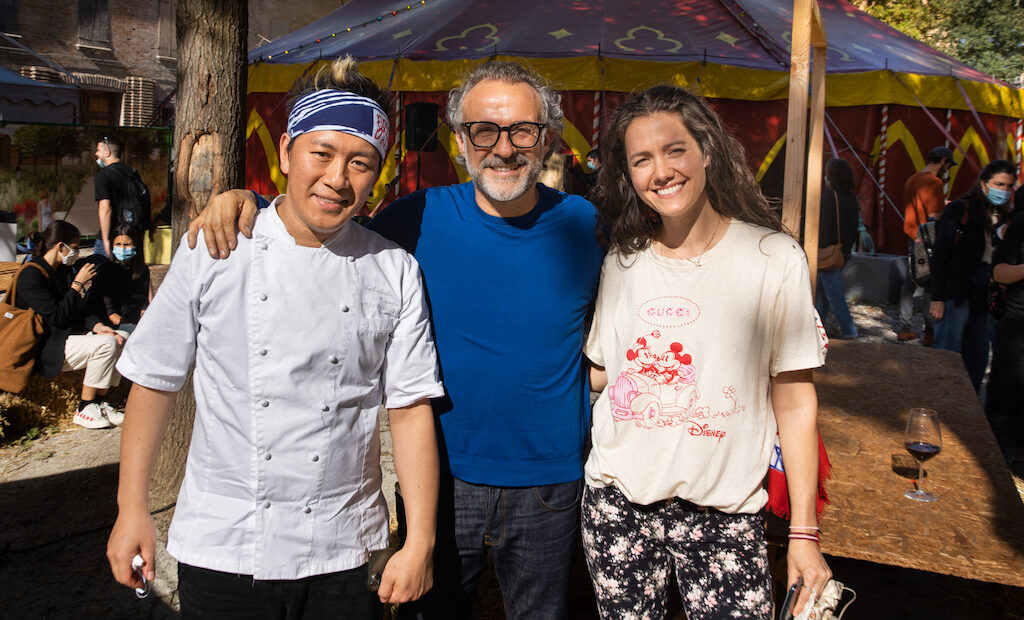
An open-air interview with a group of international journalists at Al Méni sees people gathering around, captivated by Massimo Bottura as he speaks about the good things that came from the lockdown, and the responsibility that he felt towards all the families who needed escapism and help cooking food every night, which would keep them in good spirit and also aid them in making the most of leftovers.
Food waste was another major point of discussion, as well as how an overcooked spaghetti staff meal turned into one of the classic dishes of Osteria Francescana. As questions got more profound, a comparison between the creative process of an artist and the one of a chef arose.
How did you experience the lockdown?
Probably it’s been the toughest period of our lives. From the evening of the 10th of March we decided to use the precious time created by covid with my daughter and an iPhone, for three months. I decided to use this time as best as I could to create something extremely special. First of all I felt immediately there was such a darkness all around me, all round the world. But I realised immediately since we first connected that we were all under the same roof. From the thousand messages I was receiving, I was saying to my daughter Alexa: it’s unbelievable, we have to go on and on. And we did 75 nights, one after the other, connected with the world, not to do a masterclass but to bring joy to the families all over the world. We won a Webby award. The United Nations asked me to do a speech for earth day. Facebook published my interview just to say it’s exactly what the social media are made for. We were connected with Ferrari to build a new restaurant that is going to open in March, [designed by] a Parisian architect. We were connecting with Gucci finishing the rendering of the new restaurants in Tokyo. We did the new menu of Osteria Francescana. I connected 103 people in Modena because they all decided to spend the lockdown in Modena. We decided to do something very special and create a very new menu. Inspired by the cover of the Beatles, not the album itself [Stg Pepper]. The meaning of our creation was to express the culture and biodiversity of Osteria Francescana. Here [next to me] there’s Taka [Kondo] from Japan and Jessica [Rosval] from Montreal. Then we have people from San Paolo, from everywhere. I decided to step back and leave them the space to express themselves. The result was an incredible menu. Probably the most important menu of our history, and it’s called With a Little Help from My Friends. The chef steps back and leaves the stage to the team. By myself I’m Massimo Bottura, all together we are Osteria Francescana.
We did [it], we passed through that [tough time], and in the moment, the second of June, when we decided to re-open Osteria. We had a long line of people outside waiting for lunch. And immediately when they saw me they started clapping and I felt that the darkness was over. The light of creativity, of joy, of the future, was there with us, And immediately it was a party. We haven’t lost a single table: Franceschetta, Francescana or Casa Maria Luigia. After Francescana, the 9th of June, we decide to create a new experience, thanks to Jess. She decided to create a barbecue using fire and invited all the locals to come to Maria Luigia. The locals had heard about Maria Luigia, and its farm [that was there] since 70/75, but didn’t have the opportunity to see it. An old farm where we produce fresh herb, fruit, vegetables, wheat and buckwheat, lentils… That was a renaissance. It’s exactly what I meant when [earlier] I spoke about culture. I was putting my focus on the museum [behind us] and I was talking about culture, because culture is life, it’s the [pinnacle] of human existence.
Culture brings light to the darkness of these times we are living. This is what we have done. We all decided to stay in Modena, the whole summer; they decided to keep the restaurant open the entire month of August, no holidays. And opened on Sunday because chef de parties felt like they had to give back something “for what you did for us during the lockdown”. The menu was created everyone who was meeting at Maria Luigia during Saturday and Sunday when we were cooking for nurses, doctors, and after we had time together, practising, deconstructing, rebuilding, changing the old process of creating a menu. Three months of work of 103 people. Covid gave us precious time, it gave us the opportunity to express ourselves it in the best way we could, so I cannot regret anything. Sometimes I felt extremely bad, and lonely, and down, but I remember one night in the middle of April, my daughter came to be at three in the morning, and she said: “Dad, if you’re falling, everything is going to fall with you.” So I thought about those words, and I [told myself] “I have to be alright”. And I woke up with a totally different state of mind. I think these three months that we spent like that was incredible for our team, for our family, to rejoin, everyone connected with the other to create a stronger group of people to project Osteria Francescana into the future.
People couldn’t travel, so chefs travelled to the people. During the lockdown you took Modena to Milan with the Franceschetta delivery pop-up. Do you think this could be part of the future of restaurants?
During the lockdown I had a conversation with Grant Achatz who I think was the one who organised himself better than any other the delivery. It was by chance. They saw that around 5:30pm, there was a big line of people moving and stopping close to Alinea, because Alinea is on a [major] street [in Chicago]. So they decided to creat this “to go” in the parking lot of Alinea, and I was following Grant because I saw amazing things going on, and I said: “This guy is doing really great.” I think with Franceschetta we decided to involve everyone, all the apartments where my guys are staying are close to Francescana. So we used the kitchen in Francescana to prepare all the meals to go. My experience – because they delivered to my home too – was very good. It was perfectly thought. The pasta was not pre-cooked, it’s up to you to be part of the experience: you have to cook the pasta as you want, we prepared a sauce and the meat as it has to be, with all the instructions as an Ikea to go, it was very easy and we had great feedback. This could be a very good solution, but I’m Italian and my approach to people is, I want to hug you, shake your hand, feel your energy. [Like this, ] This is not possible. What we have done, when we re-opened on the 9th [of June] with the barbecue in Maria Luigia, we used the big garden, people were having this culinary experience in the middle of 250-year-old oaks. Or Lebanon cedars, or sequoia trees. You were like: “Oh my god, where am I?” In the middle of the country in Modena, where a Canadian (Jess) is cooking with fire and smoke, experience the elderflower vinegar mixed with chive, flowers, Chimichurri or roses. Amazing. So that for me could be a much better future than delivery.
What do you think Taka? (asks Bottura)
Takahiko Kondo: I agree!
What do you think Jess? (asks Bottura)
Jessica Rosval: I agree. (Everybody laughs)
JR: I think that delivery is definitely something that helped us out during quarantine to feel like we were still a part of this community and supporting restaurants which was fundamental at that time. Even after we have this freedom now, the most people stay at home, it is still that isolating feeling. Why do that when we can get out and sit around the table again, with other people and share a meal, which is something so natural. It’s what brings people together. I think the future in a perfect world would be finding more dining ways that will help people feel closer to each other again, as opposed to facilitating that isolation of dining. I’m not saying that once in a while a nice delivery isn’t a good idea, but in terms of the future let’s make eating real again.
MB: I was talking with Taka now about Tokyo, and how in apartments the architects don’t put a kitchen anymore. Because the spaces cost so much money per square metre that they don’t want it anymore, because there’s so much delivery. So many offers. It’s normal for them. That’s why you saw the tagliolini served before [by Taka at the food stand], it’s cold. You have the whole preparation just made, and on the other side you have the sauce. You just have to pour. Maybe warm it up a little bit and then pour it on top. And then probably eat with your hands, like I did it. This is your tool!
Al Méni! [the name of the event]
MB: Yes, “al méni”, meaning “le mani”, “your hands” in English.
Some time ago you declared war to Spaghetti Bolognese
MB: Yes. At least I won because I shown that you can eat better, find a right solution, a dream. I’ve always thought about serving emotions. Coming to Osteria Francescana and Maria Luigia, it’s about emotion, not just eating good food. Of course it’s good food, it’s a three-michelin-starred experience. But I think it’s much more than that. That’s why when we closed on the 9th of March we had 223,000 people on waiting list, [clearly it’s not just for good food]. The experience is different in Osteria, it’s about emotions. To me, using the spaghetti and Bolognese sauce, to explain… Remember when we were in Moscow? The chefs behind the scenes took one of the chips and they said “this is the most famlous chip in the world”. A chip of spaghetti: [one with] tomato, [one with] parmigiano and [one with] fresh herbs, transformed into the crunchy part of the lasagna. To rejoin spaghetti and bolognese sauce. The crunch galletta on top [of the lasagna] is the expression of the spaghetti, with the velvety sauce. If you serve spaghetti and meaty sauce, all the sauce stays at the bottom of the plate. You eat the pasta, and then you have to eat the sauce. But like that, you match the two. You get a piece of crunchy lasagna, you go into the sauce, and béchamel, you eat it and you experience the joy of a kid who steals the crunchy part of the lasagna from the big pan that the grandmother brings every Sunday for the family. The rest is for the adults, but the kid knows that the best part is the crunchy part.
Food waste is something that you care a lot about, do you think it’s becoming more difficult after coronavirus?
MB: With food waste, we’ve been more active than ever [before]. The reaction of all our refettorios has been incredible, we actually opened a refettorio in Mexico at the beginning of April. We are opening one in Lima in a couple of weeks. I received emails from Gastón Acurio, Virgilio [Martinez] and Micha [Mitsuharu Tsumura ] saying that they will take care of the refettorio in Lima, they said: “I know you can’t come so we’re going to take care of it.” That’s the spirit of refettorios, putting together communities. People believe in change: London, Paris, Milan. Milan was the only refettorio that never closed, it started serving at 12 and finished at 8pm. They kept serving people six at a time. In Paris, where artist JR partners with me, they put together all these chefs – they’re still in lockdown – and they were serving between 3,800 and 5,000 meals every day. Incredible.
But how do you do it with social distancing?
MB: We had a little track filled with meals to go, and we were feeding people in the most neglected neighbourhoods in Paris. In London, same thing. They told me there was a line behind Earl’s Court that was incredible. All the homeless of the area.
Was there an increse during lockdown?
MB: During lockdown there was a big increase of demand, but the volunteers are the contemporary angels. [They are] the real heroes in this situation. They’re doing an incredible job.
How many volunteers?
MB: Just in Paris there are 4,000 volunteers on the waiting list, just to be a part. The chefs in London – all the guys from [restaurants such as] The Ledbury – pushed all their apprentices and commis to work on their days off to understand the meaning of cooking as an act of God. È bellissimo! (it’s beautiful).
What are the limits of a freedom of a chef to create their own cuisine? Because, like for spaghetti bolognese, some ingredient shouldn’t be misused right?
MB: There is no border for creativity. Creativity is creativity. Creativity is the [pinnacle] of human existence.
JR: I don’t want to say something that might seem obvious – Massimo you say it all the time too. I think that the difference between an artist and a chef is the artist has full creativity, where they’re just trying to provoke feelings and responses and emotions out of people, which is something that a chef tries to do my manipulating ingredients. But we’re just limited to the one, very basic rule that it needs to be eaten afterwards. As long as you can eat it and it tastes good, and it speaks to the palate. I think that those are the rules that not in a way limit us, but guide us in terms of the creative process. You can go as crazy as possible but eating is still the act. That’s still the goal. Eating and provoking those emotions through food, you swallow it, digest it, and then the feelings come afterwards. In a perfect world that would be the only limit that there is.
MB: It’s like this, in a very short sentence. There are artists and art critics that right now are telling us that our creative process is exactly as the process of an artist. Achille Bonito Oliva [said it]. [Take] Oops I Dropped the Lemon Tart, it’s exactly an artist’s process, a mistake. During the journey of creativity you fall and suddenly you see the world from another perspective. That perspective was invisible till one minute before then. But if you don’t get lost into everyday life, that moment is when you catch the flash in the dark, and you create something brand new that’s never been created. Contemporary means “I know everything and I forget about everything”. But first of all, I know everything. Oops I Dropped the Lemon Tart inspired a group show in New York called I Dropped the Lemon Tart at the Lisa Colley Gallery, in Soho. The artists were inspired by a broken lemon tart to create art. But the chef is still an artisan. An artisan, in our case, obsessed about quality. The quality of the idea, of the ingredient, the quality of the food you serve. An artist is free to do whatever he wants. So, [Piero] Manzoni was putting his faeces in cans. Of course, it wasn’t [faeces], but it was called Artist’s Shit. That was 1960s. So the point is [that] a chef has a dialogue is with your palate, the dialogue of an artist is with your mind. So I have to create good food for you, [whereas] he has to open your mind. But, in the way we’re cooking, there’s a creative process that is extremely similar to that of an artist. It’s a very big argument, we can go on and on. Picasso was always saying: copying yourself is a very sterile exercise, but stealing from others is necessary. So stealing ideas from Cucchi, Clemente, Paladino, De Maria, Damien Hirst, all the artists that you see there [a modern and contemporary art museum in front of the chef]. If we wanted to do an exercise, we [could] go into that museum, we stay one hour, checking and experiencing, breathing that energy; [then] we would come and create a menu. I know that it’s going to be like that. Because what we do everyday in our lives, we compress our passion into edible bites. Sitting on centuries on history – it’s extremely Italian – and filtered by contemporary mind. So, we bring the best from the past into the future, not in a nostalgic way, but in a critiqued way. That’s why we create the crunchy part of the lasagna.
If we take the next step. There’s no World’s 50 Best list this year and – it’s a controversial question – but if chefs at very top level are artists, you’d never say Monet is better than Picasso or Dali. Cooking is culture, and culture is subjective, there shouldn’t be a list?
MB: I think that we already did a very important humanistic revolution in 2015, now it’s everywhere [with the refettorios]. Everyone is embracing it, probably without the 50 Best I couldn’t have such a result because the title in Rio de Janeiro, for the second experience of the refettorio, was “[the] best restaurant in the world is opening a soup kitchen in the most neglected neighbourhood in Rio”. It’s a big title, it’s explosive. We [started] an incredible revolution, everybody talks about food waste, everybody is alert to climate change, and in probably three days you’re going to read big news on the United Nations that I can’t say now, because I’m going to break the news. It’s incredible. Right now could be a pause to reflect and say: what do we really need? Do we need a first, second, third ranking? I like your reflection comparing Monet to Picasso, Cézanne to Kandinsky, or is it better Cubism or Futurism? Fauvism or Surrealism? What is that? Is it better Italian or French cuisine? It’s about influence, it’s not about what’s best. At one point, they decided to take off me, the Rocas and René, because the last 12 years we were, number one, number two, number three. Francescana is now fully booked till the 31st of March. I think your reflection is extremely intelligent and deep. You’re supposed to go to London, the organisers of the 50 Best, and and ask that question to them.
What can normal people do to improve on food waste and how do you think the refettorio will change in the next ten years?
MB: Taka did a crazy thing that can help you understand our approach to food waste. Choy, our pasta chef de partie, after one year at that section he said: “Chef, I’m going to cook pasta and pesto for the team.” He’s a Korean, guy, I said: “Are you sure you want to do pasta and pesto?” He said yes. So there were 65 Italian chefs eating for lunch a staff meal, and Choy took his risk to cook pasta and pesto. The moment it arrived, it was overcooked. He chose spaghetti. Imagine cooking for 65 Italian chefs spaghetti. It was overcooked. Davide [di Fabio] started immediately to take care of the staff meal, but Taka looked at the overcooked spaghetti in a big barrel and said: “Here, we don’t waste anything. This is our philosophy. So I’m going to make miso out of the spaghetti.” And he started mixing the spaghetti and ferment them as if it was miso. Three months later, the result was so incredible, that we created a chawanmushi; we got parmigiano reggiano water – from old shaves of parmigiano, that we use for riso cacio e pepe – mixed with toasted pine nuts, all the element of pesto, egg whites, and we cooked chawanmushi in the oven. String beans, potatoes and all the herbs from Maria Luigia; and we put on top the miso fermented from pasta and pesto. As Jessica says, pesto for us is a..
JR: Concept!
MB: It’s not a recipe, you can make pesto out of basil, but also add mint, or breadcrumbs if you don’t have pine nuts. As we did at the refettorio in Milan. [The result] is crunchy and it’s in our menu at Maria Luigia, with the classics of Osteria Francescana. A chawanmushi of parmigiano and pine nuts, crunchy string beans and potatoes, all the fresh herbs, and poured on top the miso fermented of pasta and pesto. That’s the way you approach food. And Kitchen Quarantine, every night we were showing how to clean a refrigerator. It was not a masterclass, it was a simple exercise for every single family to understand how to not waste anything. Charlie [Bottura, his son] was Charlie, we didn’t want to waste Charlie’s mind, so we were cooking as he wanted, like the dessert at the end. That’s the idea. From a mistake you can [make something great]. The important thing is to always keep in mind the dream, because you can get lost in the everyday life. Our job is one of the most alienating jobs, because you go into the kitchen, you compress in there, you cook, you cut, you’re breaking, and sauteing, and serve. It’s not like that. Our job is about dreaming. It’s about creating and creativity. This is what it is.
[the public applaudes and the chef realises people have gathered around him to listen]
MB: I didn’t realise [you were around us]! Thanks! One thing that is extremely important is that we talk about the team. With a Little Help from My Friends. If we can do Identità Golose (major Italian food convention), it if there’s not lockdown, I am probably not going to go on stage. They are going on stage! And they are presenting the whole menu that is With a Little Help from My Friends. Start from the bread: Michele, Mirco… all the bakers were developing a new bread for Franceshetta to Go, they developed a bread that’s like a mille-feuille, with honey from Maria Luigia and salt from Cervia. When I tasted it I said: this is not bread, it’s something much more. I cannot reduce this creation to a simple bread serving. So I put it on the menu, as a course, and it’s called A Day in the Life, one of the most beautiful songs of Sergeant Pepper.
Can you try and explain the process of coming up with a new dish? How it starts with an idea and ends up on a plate.
JR: I think that very briefly is probably not the best way to do this. I think the most important thing is surrounding yourself with the right inspiration. Choosing the right mentors. So of course working for Massimo, someone who guides and teaches us in everything we do. And then having a great team. Once you finally have that inspiration, you have that idea where you want to go with something, keep yourself open to all of those suggestions from other people. Just like With a Little Help from My Friends. I’m using this as an example because it’s more direct. Brainstorming all of these dishes is something that kept the entire team connected over all of the quarantine. Through our WhatsApp group chat, everybody talking about each other’s ideas, going into the restaurant, the kitchen, from the bakery to pastries, to the service kitchen to the laboratory, became this creative workshop where everybody collaborated. It’s about putting your ego aside and the best results will come when you really open yourself up to getting input from other people with their different specialisations. I think it’s all about keeping your egos down as you start to create something and letting space in for the people around you who can influence you to make something beautiful. That’s what we’ve seen as a team at Francescana and that’s what’s extra special about the menu that’s being served there right now.
Some of the best works of art came after very dark moments.
MB: That’s why I said the best menu we ever created is With a Little Help from My Friends. I know it. It was a collective exercise where 103 creative minds, they decided to do something. We start with words. Usually we do an exercise with the apprentices called “who are you?”. So we try to teach all the apprentices how to express themselves through edible bites. Tell me who you are and where you come from. What they tell me makes it a very creative exercise, beautiful. At one point, we did this with words, to interpret the cover of Sgt Pepper’s Lonely Hearts Club Band – not the music. The words were so intense, deep and incredible that I said: “You have a couple of weeks to create something.” After, the result was extremely positive. So we started working on it. Everyone: me, Jess, Davide, Taka, Choy. All the chefs were moving, changing, balancing. With a Little Help From My Friends is a journey, it’s the most contemporary menu because it’s expressing culture, biodiversity in Francescana, the time that we are living in. It’s a journey around the world in a moment in which you are locked in your place. So at one point you are in the 80s eating risotto and strawberry marinated in lambrusco – which has a back taste of tomato. So we called Raffaele Barlotti, the best buffalo mozzarella producers, to have mozzarella, 700 grams, full of milk. We put the mozzarella into the Greenstar [extractor] and extract the juice from the buffalo mozzarella, lightly smoked. So risotto, strawberry and lambrusco, a touch of fermented milk extracted from the buffalo mozzarella, lightly smoked. What do you need when you have mozzarella and tomato? Fresh herbs from Maria Luigia! So every single bite is different because you travel through the different herbs at the bottom of the plate. The aftertaste was a little bit bitter, so at that point we added sweetness from the red shrimp from Mazara del Vallo. So we made a tartare of red shrimp at the bottom of the plate. The hot risotto was going on top of the shrimp and changed the texture of it. So with a spoon you get into the herbs, the shrimp, the risotto and the buffalo mozzarella and you eat the Mediterranean, the 80s transform into the era 2020.
Next course is the cod. From Italy, from the 80s, we travel to Bangkok. We always travel with an open mind and when we taste something special we ask: how can we make this? Most of the time, the Thai food is too aggressive, it’s too intense. The problem is always the aftertaste. So we created a green curry starting from the curry leaves, then ginger, then lemon grass, then kaffir lime, then coconut milk, then the zest from a lime, just squeezed. We keep the juice on the side and then add it without taking off all the garlic, onion and spice. Connect and balance the spicey-ness to get long into the palate. Why do we do that? To be critic and not nostalgic. And the cod is expressing itself after it’s been marinated into…
JR: Salt, sugar, lemon grass, lime and ginger…
MB: Turmeric! And then we steam it, and then we aggressively cook in the pan, then again in the oven, and on top, the cod is melting on the palate. You have this beautiful plate, all with different sauces from the green of the green curry. And there are green and white flowers on the plate. You are in Bangkok.
And after that, dumpling! In Modena! We are serving dumplings in Modena! Can you believe it? The creative mind has to take risks in this darkness to bring the light of creativity to everybody. Choy, who is still here despite the mistake in the past – always happy ending in Francesana (laughs) – made this amazing pasta for dumpling. It melted in the palate. Then she’s (Jess) doing a pork belly, smoked 16 hours in the smoker, and lacquered with maple syrup. Then, matched with clams from Palestrina, Venice. You mix clams and pork belly? What do you have? New England clam chowder. What happens then? Taka, critically, he cleans the New England clam chowder from butter and cream, and makes a clam juice. A New England clam chowder that disappears in the palate, matching the dumpling.
The name of the plate is We Are All Connected Under One Roof. [A] Canadian, Taiwanese, Korean, Japanese and [a] guy from Venice, all bringing something to the team. And we create that. That is an example of what is Osteria Francescana.
Filippo L’Astorina
Photos: Filippo L’Astorina

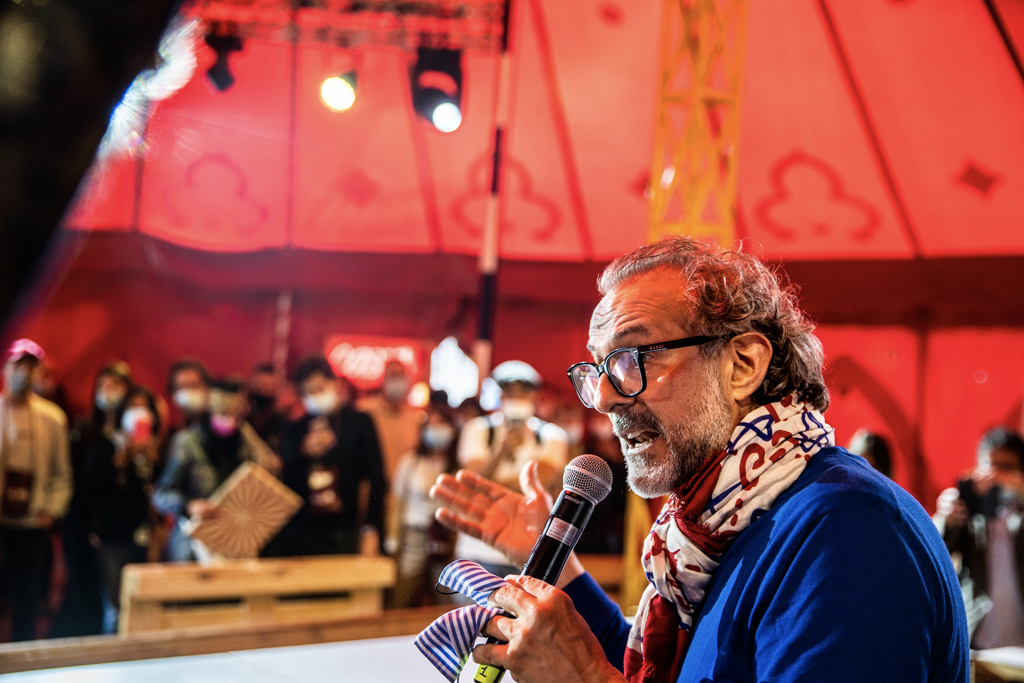
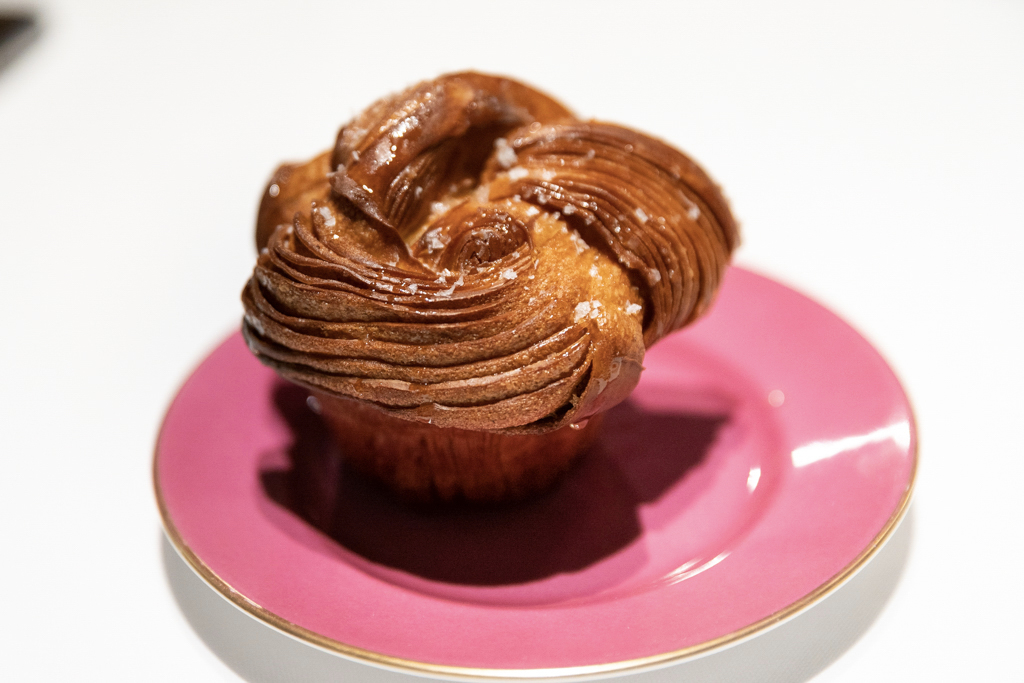
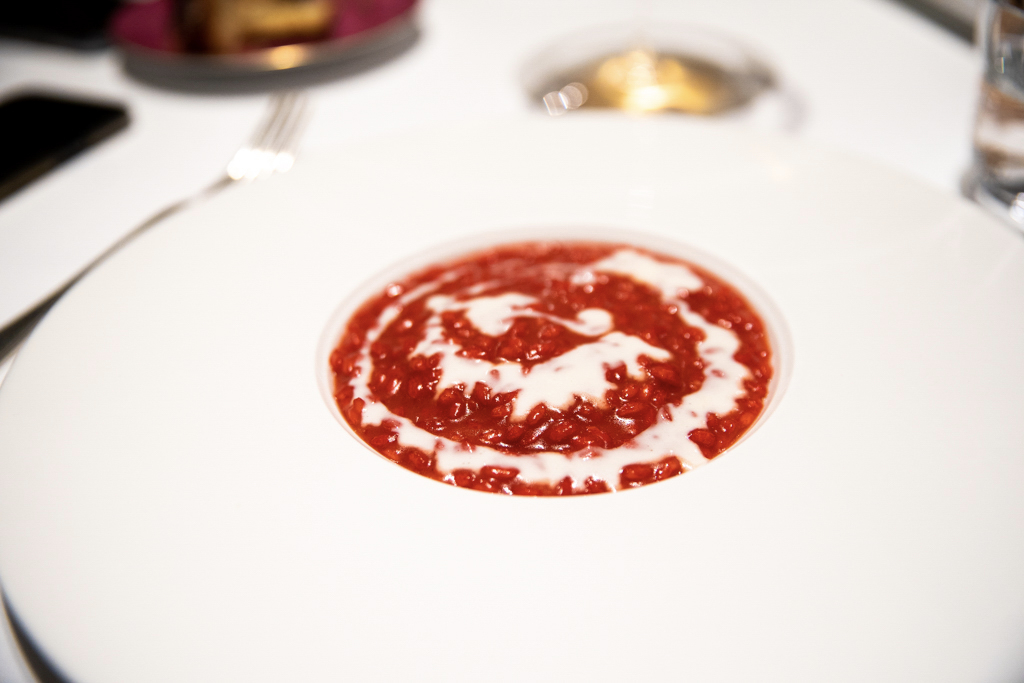
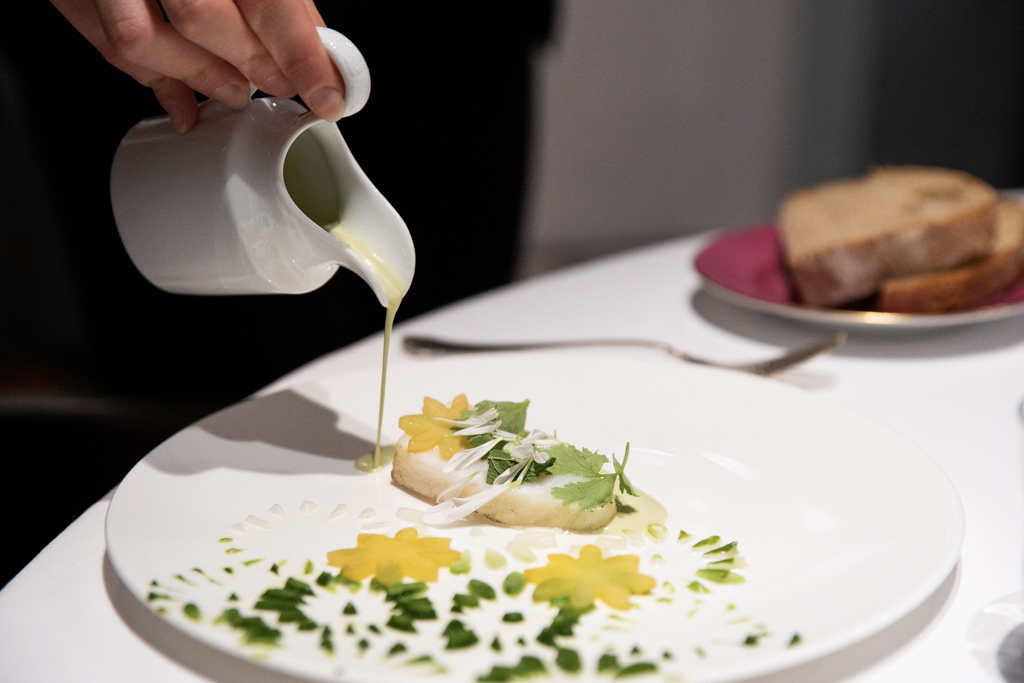
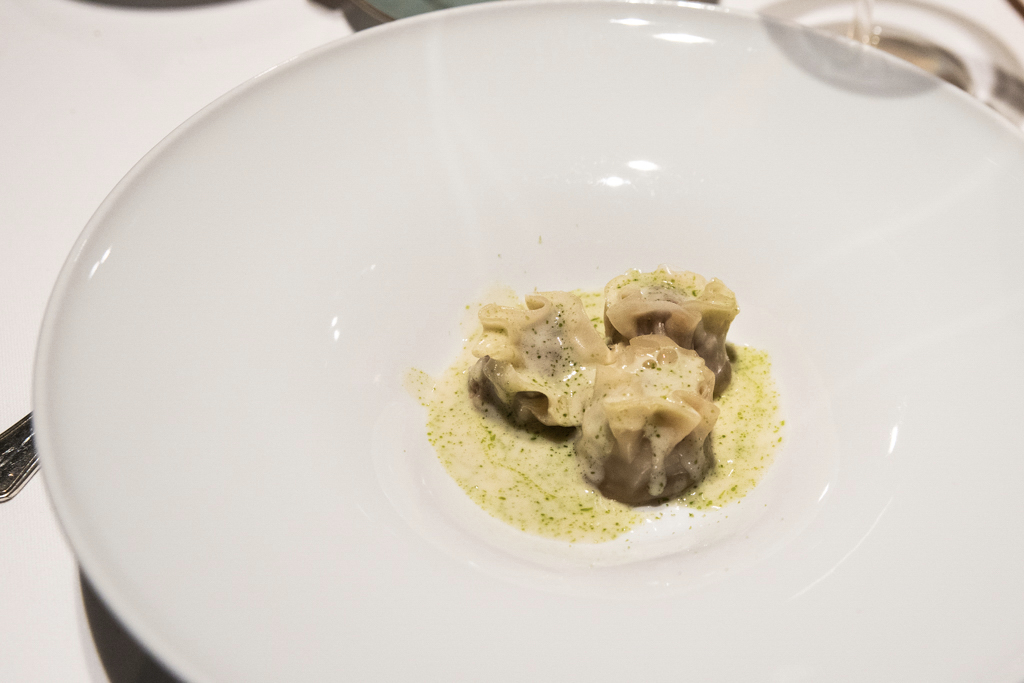
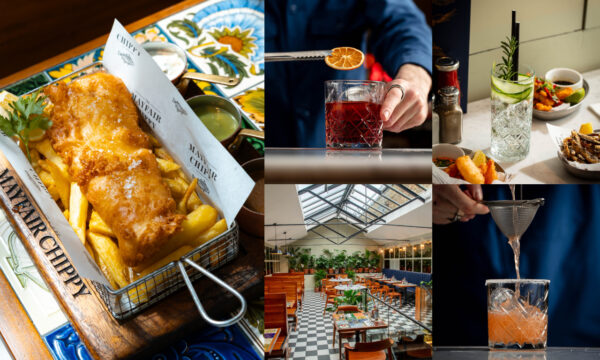
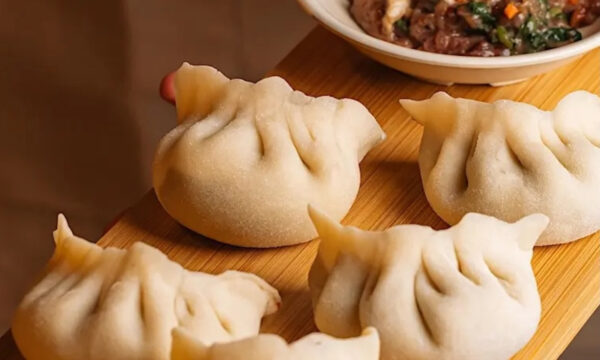
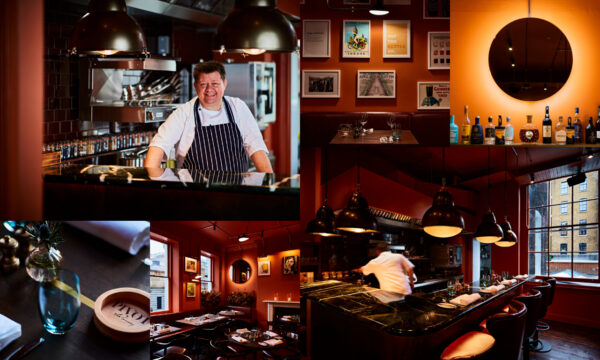
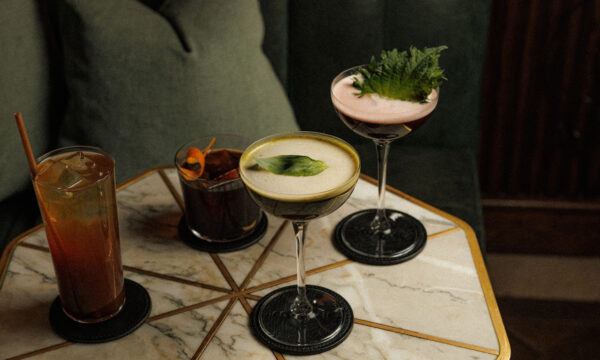
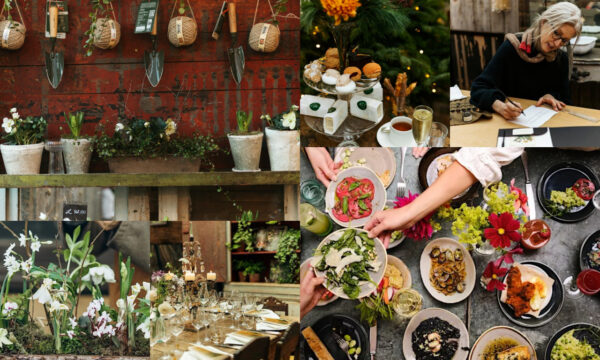
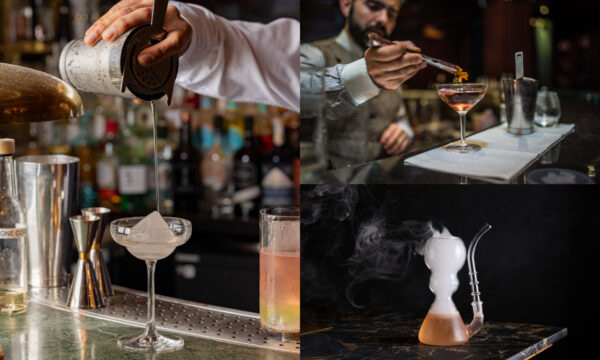

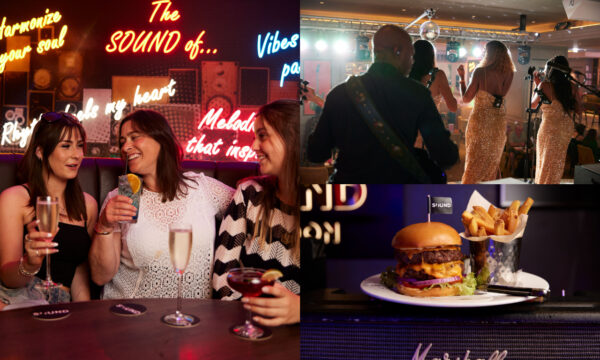
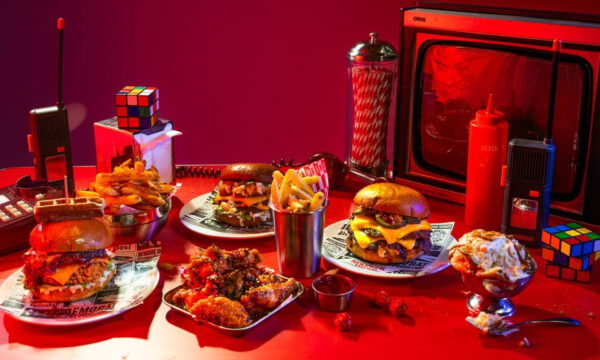
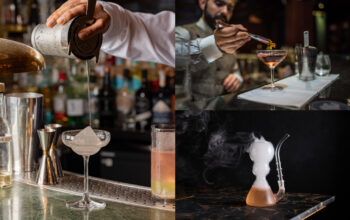

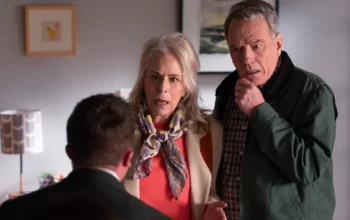
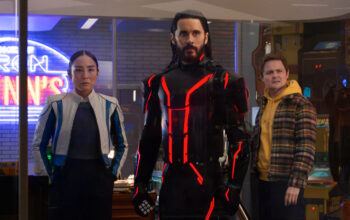
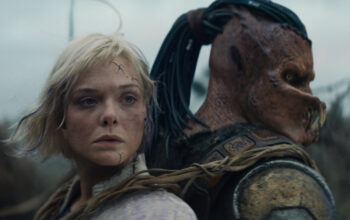

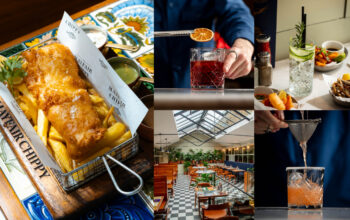





Facebook
Twitter
Instagram
YouTube
RSS